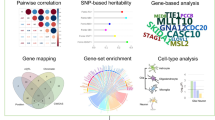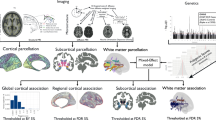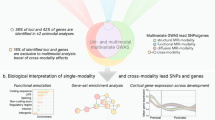Abstract
Improved understanding of the shared genetic architecture between psychiatric disorders and brain white matter may provide mechanistic insights for observed phenotypic associations. Our objective is to characterize the shared genetic architecture of bipolar disorder (BD), major depression (MD), and schizophrenia (SZ) with white matter fractional anisotropy (FA) and identify shared genetic loci to uncover biological underpinnings. We used genome-wide association study (GWAS) summary statistics for BD (n = 413,466), MD (n = 420,359), SZ (n = 320,404), and white matter FA (n = 33,292) to uncover the genetic architecture (i.e., polygenicity and discoverability) of each phenotype and their genetic overlap (i.e., genetic correlations, overlapping trait-influencing variants, and shared loci). This revealed that BD, MD, and SZ are at least 7-times more polygenic and less genetically discoverable than average FA. Even in the presence of weak genetic correlations (range = −0.05 to −0.09), average FA shared an estimated 42.5%, 43.0%, and 90.7% of trait-influencing variants as well as 12, 4, and 28 shared loci with BD, MD, and SZ, respectively. Shared variants were mapped to genes and tested for enrichment among gene-sets which implicated neurodevelopmental expression, neural cell types, myelin, and cell adhesion molecules. For BD and SZ, case vs control tract-level differences in FA associated with genetic correlations between those same tracts and the respective disorder (rBD = 0.83, p = 4.99e-7 and rSZ = 0.65, p = 5.79e-4). Genetic overlap at the tract-level was consistent with average FA results. Overall, these findings suggest a genetic basis for the involvement of brain white matter aberrations in the pathophysiology of psychiatric disorders.
This is a preview of subscription content, access via your institution
Access options
Subscribe to this journal
Receive 12 print issues and online access
$259.00 per year
only $21.58 per issue
Buy this article
- Purchase on Springer Link
- Instant access to full article PDF
Prices may be subject to local taxes which are calculated during checkout





Similar content being viewed by others
Code availability
All tools used in this study are publicly available including: MiXeR v1.3 (https://github.com/precimed/mixer), cond/conjFDR (https://github.com/precimed/pleiofdr), LD score regression (https://github.com/bulik/ldsc), bedtools (bedtools.readthedocs.io), FUMA GWAS (https://fuma.ctglab.nl/).
References
Marner L, Pakkenberg B. Total length of nerve fibers in prefrontal and global white matter of chronic schizophrenics. J Psych Res. 2003;37:539–47.
Catani M, ffytche DH. The rises and falls of disconnection syndromes. Brain. 2005;128:2224–39.
Thiebaut de Schotten M, Forkel SJ. The emergent properties of the connected brain. Science. 2022;378:505–10.
Fields RD. White matter in learning, cognition and psychiatric disorders. Trends Neurosci. 2008;31:361–70.
Alnæs D, Kaufmann T, Doan NT, Córdova-Palomera A, Wang Y, Bettella F, et al. Association of Heritable Cognitive Ability and Psychopathology With White Matter Properties in Children and Adolescents. JAMA Psych. 2018;75:287–95.
Zalesky A, Fornito A, Seal ML, Cocchi L, Westin C-F, Bullmore ET, et al. Disrupted Axonal Fiber Connectivity in Schizophrenia. Biol Psych. 2011;69:80–89.
Korgaonkar MS, Fornito A, Williams LM, Grieve SM. Abnormal Structural Networks Characterize Major Depressive Disorder: A Connectome Analysis. Biol Psych. 2014;76:567–74.
Mahon K, Burdick KE, Szeszko PR. A role for white matter abnormalities in the pathophysiology of bipolar disorder. Neurosci Biobehav Rev. 2010;34:533–54.
Beaulieu C Chapter 8 - The Biological Basis of Diffusion Anisotropy. In: Johansen-Berg H, Behrens TEJ, editors. Diffusion MRI (Second Edition), San Diego: Academic Press; 2014. p. 155–83.
Kelly S, Jahanshad N, Zalesky A, Kochunov P, Agartz I, Alloza C, et al. Widespread white matter microstructural differences in schizophrenia across 4322 individuals: results from the ENIGMA Schizophrenia DTI Working Group. Mol Psych. 2018;23:1261–9.
van Velzen LS, Kelly S, Isaev D, Aleman A, Aftanas LI, Bauer J, et al. White matter disturbances in major depressive disorder: a coordinated analysis across 20 international cohorts in the ENIGMA MDD working group. Mol Psych. 2020;25:1511–25.
Favre P, Pauling M, Stout J, Hozer F, Sarrazin S, Abé C, et al. Widespread white matter microstructural abnormalities in bipolar disorder: evidence from mega- and meta-analyses across 3033 individuals. Neuropsychopharmacol. 2019;44:2285–93.
Beaulieu C. The basis of anisotropic water diffusion in the nervous system – a technical review. NMR Biomed. 2002;15:435–55.
Johansson V, Kuja-Halkola R, Cannon TD, Hultman CM, Hedman AM. A population-based heritability estimate of bipolar disorder – In a Swedish twin sample. Psych Res. 2019;278:180–7.
Smeland OB, Frei O, Dale AM, Andreassen OA. The polygenic architecture of schizophrenia — rethinking pathogenesis and nosology. Nat Rev Neurol. 2020;16:366–79.
Kendler KS, Ohlsson H, Lichtenstein P, Sundquist J, Sundquist K. The Genetic Epidemiology of Treated Major Depression in Sweden. AJP. 2018;175:1137–44.
Hindley G, Frei O, Shadrin AA, Cheng W, O’Connell KS, Icick R, et al. Charting the Landscape of Genetic Overlap Between Mental Disorders and Related Traits Beyond Genetic Correlation. AJP. 2022;179:833–43.
Vuoksimaa E, Panizzon MS, Hagler DJ Jr, Hatton SN, Fennema-Notestine C, Rinker D, et al. Heritability of white matter microstructure in late middle age: A twin study of tract-based fractional anisotropy and absolute diffusivity indices. Hum Brain Mapp. 2017;38:2026–36.
Zhao B, Li T, Yang Y, Wang X, Luo T, Shan Y, et al. Common genetic variation influencing human white matter microstructure. Science. 2021;372:eabf3736.
Zhao B, Zhang J, Ibrahim JG, Luo T, Santelli RC, Li Y, et al. Large-scale GWAS reveals genetic architecture of brain white matter microstructure and genetic overlap with cognitive and mental health traits (n = 17,706). Mol Psyc. 2019;26:3943–55.
Mullins N, Forstner AJ, O’Connell KS, Coombes B, Coleman JRI, Qiao Z, et al. Genome-wide association study of more than 40,000 bipolar disorder cases provides new insights into the underlying biology. Nat Genet. 2021;53:817–29.
Wray NR, Ripke S, Mattheisen M, Trzaskowski M, Byrne EM, Abdellaoui A, et al. Genome-wide association analyses identify 44 risk variants and refine the genetic architecture of major depression. Nat Genet. 2018;50:668–81.
Hyde CL, Nagle MW, Tian C, Chen X, Paciga SA, Wendland JR, et al. Identification of 15 genetic loci associated with risk of major depression in individuals of European descent. Nat Genet. 2016;48:1031–6.
Trubetskoy V, Pardiñas AF, Qi T, Panagiotaropoulou G, Awasthi S, Bigdeli TB, et al. Mapping genomic loci implicates genes and synaptic biology in schizophrenia. Nature. 2022;604:502–8.
Frei O, Holland D, Smeland OB, Shadrin AA, Fan CC, Maeland S, et al. Bivariate causal mixture model quantifies polygenic overlap between complex traits beyond genetic correlation. Nat Commun. 2019;10:2417.
Holland D, Frei O, Desikan R, Fan C-C, Shadrin AA, Smeland OB, et al. Beyond SNP heritability: Polygenicity and discoverability of phenotypes estimated with a univariate Gaussian mixture model. PLoS Genet. 2020;16:e1008612.
Bulik-Sullivan BK, Loh P-R, Finucane HK, Ripke S, Yang J, Patterson N, et al. LD Score regression distinguishes confounding from polygenicity in genome-wide association studies. Nat Genet. 2015;47:291–5.
Kang HJ, Kawasawa YI, Cheng F, Zhu Y, Xu X, Li M, et al. Spatio-temporal transcriptome of the human brain. Nature 2011;478:483–9.
Watanabe K, Taskesen E, van Bochoven A, Posthuma D. Functional mapping and annotation of genetic associations with FUMA. Nat Commun. 2017;8:1826.
Bhaduri A, Sandoval-Espinosa C, Otero-Garcia M, Oh I, Yin R, Eze UC, et al. An Atlas of Cortical Arealization Identifies Dynamic Molecular Signatures. 2021;598:200–204.
Li M, Santpere G, Kawasawa YI, Evgrafov OV, Gulden FO, Pochareddy S, et al. Integrative functional genomic analysis of human brain development and neuropsychiatric risks. Science 2018;362:eaat7615–eaat7615.
Zeisel A, M͡oz-Manchado AB, Codeluppi S, Lönnerberg P, Manno GL, Juréus A, et al. Cell types in the mouse cortex and hippocampus revealed by single-cell RNA-seq. Science 2015;347:1138–42.
Parker N, Patel Y, Jackowski AP, Pan PM, Salum GA, Pausova Z, et al. Assessment of Neurobiological Mechanisms of Cortical Thinning during Childhood and Adolescence and Their Implications for Psychiatric Disorders. JAMA Psych. 2020. 2020. https://doi.org/10.1001/jamapsychiatry.2020.1495.
Liao Z, Patel Y, Khairullah A, Parker N, Paus T. Pubertal Testosterone and the Structure of the Cerebral Cortex in Young Men. Cereb Cortex. 2021;31:2812–21.
Meyer-Lindenberg A, Weinberger DR. Intermediate phenotypes and genetic mechanisms of psychiatric disorders. Nat Rev Neurosci. 2006;7:818–27.
Gottesman II, Gould TD. The Endophenotype Concept in Psychiatry: Etymology and Strategic Intentions. AJP. 2003;160:636–45.
Cheng W, van der Meer D, Parker N, Hindley G, O’Connell KS, Wang Y, et al. Shared genetic architecture between schizophrenia and subcortical brain volumes implicates early neurodevelopmental processes and brain development in childhood. Mol Psych. 2022:1–10.
Cheng W, Frei O, van der Meer D, Wang Y, O’Connell KS, Chu Y, et al. Genetic Association Between Schizophrenia and Cortical Brain Surface Area and Thickness. JAMA Psych. 2021;78:1020–30.
Werme J, van der Sluis S, Posthuma D, de Leeuw CA. An integrated framework for local genetic correlation analysis. Nat Genet. 2022;54:274–82.
Parker N, Cheng W, Hindley GFL, O’Connell KS, Karthikeyan S, Holen B, et al. Genetic Overlap Between Global Cortical Brain Structure, C-Reactive Protein, and White Blood Cell Counts. Biol Psych. 2023. 20 June 2023. https://doi.org/10.1016/j.biopsych.2023.06.008.
Cheng W, Parker N, Karadag N, Koch E, Hindley G, Icick R, et al. The relationship between cannabis use, schizophrenia, and bipolar disorder: a genetically informed study. Lancet Psych. 2023;10:441–51.
DeRosse P, Karlsgodt KH. Examining the Psychosis Continuum. Curr Behav Neurosci Rep. 2015;2:80–89.
Kloiber S, Rosenblat JD, Husain MI, Ortiz A, Berk M, Quevedo J, et al. Neurodevelopmental pathways in bipolar disorder. Neurosci Biobehav Rev. 2020;112:213–26.
al-Haddad BJS, Oler E, Armistead B, Elsayed NA, Weinberger DR, Bernier R, et al. The fetal origins of mental illness. Am J Obstet Gynecol. 2019;221:549–62.
Lundgaard I, Osório MJ, Kress BT, Sanggaard S, Nedergaard M. White matter astrocytes in health and disease. Neuroscience 2014;276:161–73.
Galatro TF, Holtman IR, Lerario AM, Vainchtein ID, Brouwer N, Sola PR, et al. Transcriptomic analysis of purified human cortical microglia reveals age-associated changes. Nat Neurosci. 2017;20:1162–71.
Reemst K, Noctor SC, Lucassen PJ, Hol EM. The Indispensable Roles of Microglia and Astrocytes during Brain Development. Front Hum Neurosci. 2016;10:566.
Miller DJ, Duka T, Stimpson CD, Schapiro SJ, Baze WB, Mcarthur MJ. Prolonged myelination in human neocortical evolution. Proc Natl Acad Sci USA. 2012;109:16480–5.
Hakak Y, Walker JR, Li C, Wong WH, Davis KL, Buxbaum JD, et al. Genome-wide expression analysis reveals dysregulation of myelination-related genes in chronic schizophrenia. Proc Natl Acad Sci. 2001;98:4746–51.
Tkachev D, Mimmack ML, Ryan MM, Wayland M, Freeman T, Jones PB, et al. Oligodendrocyte dysfunction in schizophrenia and bipolar disorder. Lancet. 2003;362:798–805.
Acknowledgements
Funding was provided by the Research Council of Norway [grants 223273, 300309, 324252, 326813, 324499], the South-East Regional Health Authority [grant 2022-073], EEA and Norway [grant EEA-RO-NO-2018-0573], European Union’s Horizon 2020 Research and Innovation Programme [Grant 847776, 964874, the Marie Skłodowska-Curie Actions Grant 801133], and part of the convergence environment (MultiModal Mental Models [4MENT]) at the University of Oslo (UiO) Life Science. The authors have also received internationalization support from UiO:Life Science.We would like to thank the research participants for each GWAS. We additionally thank the staff at 23andMe, Inc and the Psychiatric Genomics Consortium for making this work possible and providing summary statistics. This work was performed on resources provided by Sigma2 (the National Infrastructure for High-Performance Computing and Data Storage in Norway) and the TSD (Tjeneste for Sensitive Data) facilities.
Author information
Authors and Affiliations
Contributions
NP and OAA conceived the study. NP conducted analyses and wrote the initial draft of the manuscript. NP, WC, GFLH, PP, OF, and OAA were involved in study design and provided analytical input. All authors contributed to data interpretation and editing of the manuscript.
Corresponding authors
Ethics declarations
Competing interests
OAA reported personal fees from Lundbeck, Janssen, Sunovion (speaker’s honorarium), Biogen (consultant) outside the submitted work and is a consultant to Cortechs.ai (stock options). AMD is a founder of and holds equity interest in Cortechs.ai and serves on its scientific advisory board. He also receives research funding from General Electric Healthcare (GEHC).
Additional information
Publisher’s note Springer Nature remains neutral with regard to jurisdictional claims in published maps and institutional affiliations.
Supplementary information
Rights and permissions
Springer Nature or its licensor (e.g. a society or other partner) holds exclusive rights to this article under a publishing agreement with the author(s) or other rightsholder(s); author self-archiving of the accepted manuscript version of this article is solely governed by the terms of such publishing agreement and applicable law.
About this article
Cite this article
Parker, N., Cheng, W., Hindley, G.F.L. et al. Psychiatric disorders and brain white matter exhibit genetic overlap implicating developmental and neural cell biology. Mol Psychiatry 28, 4924–4932 (2023). https://doi.org/10.1038/s41380-023-02264-z
Received:
Revised:
Accepted:
Published:
Issue Date:
DOI: https://doi.org/10.1038/s41380-023-02264-z



